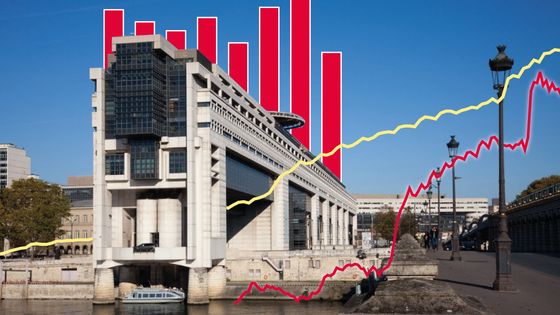
The figures published by INSEE on Tuesday morning are a little “less worse” than expected but they remain worrying. Continued growth in France has made it possible to reduce the weight of public debt and deficit in 2022, but public finances remain degraded, with debt approaching the symbolic threshold of 3,000 billion euros in absolute value.
Record Debt, Out-of-the-Box Deficit and Rising Interest Rates: “All the ingredients are in place to revive an explosive debate on public finances, without the political world taking hold of it, in particular for fear of new social tensions”, noted Agence France Presse on Tuesday morning. The Minister of the Economy, Bruno Le Maire, also welcomed the “resilience” of the economy that led to this improvement, while reaffirming its “determination (…) total” to restore public finances, in a climate electrified by the opposition to the pension reform.
We take stock of the key figures of the French public accounts in six infographics.
A high deficit but falling below 5%
It is a deficit that would seem abysmal if the Covid had not been there. In 2022, France’s deficit represents 4.7% of its gross domestic product (GDP). For example, whether the left or the right is in power, France never experienced such a level of deficit between 1996 and 2007. But the “trend” is good since the public deficit amounted to 6, 5% last year. The deficit therefore falls below the 5% target that was displayed by the executive. In value, it stood at 124.9 billion euros, benefiting from revenue remaining “dynamic” with an increase of 7.3% to 95.7 billion euros, according to INSEE.
The executive still sets itself the objective of returning below the 3% deficit bar (provided for by the Maastricht Treaty) by 2027 and the end of Emmanuel Macron’s mandate. At that point, it will be almost ten years since France fell below (2.5% deficit in 2018).
The debt is close to 3,000 billion
After the “whatever the cost” which allowed the State to support the French economy at arm’s length during the health crisis, the French debt is close to 3,000 billion euros. The bad news is that France’s public debt has increased in absolute value by 126.4 billion euros compared to 2021 (reaching 2,950 billion euros). The health crisis and then the inflation exacerbated by the war in Ukraine have been there. The good news is that last year’s 2.6% economic growth helped reduce public debt to 111.6% of gross domestic product (GDP), from 112.9% in 2021, in line with government expectations. Relative to GDP, the debt burden is therefore slightly less heavy today than a year ago.
In the European Union, only the countries of the South have a higher debt. In 2021, Spain’s debt represented 118% of its GDP, that of Portugal 127%, and that of La Grève 193.3%.
Spending down slightly
What does the amount of public expenditure reduced to the wealth created over a year represent? In 2022, expenditure represents 58.1% of GDP. This figure is logically down since the peak linked to Covid (59.1% in 2021 and 61.3% in 2020). But the health crisis has not been digested: we are still far from the 55.4% recorded in 2019 when we had never heard of the Wuhan market. In France, the ratio of public expenditure in relation to the wealth created has increased very regularly since the first oil shock. In 1974, this ratio was 39.9%.
Debt burden explodes
The debt interest charge (what France pays as debt interest without reimbursing one euro of this debt) accelerates sharply in 2022. This charge increases by 15 billion euros in one year, rising to 53.2 billion euros, an increase of nearly 40%. The interest expense represents 2.0% of GDP, its highest level since 2016.
By way of comparison, France devotes
twice as much money to pay the interest on its debt than to research and higher education (26.4 billion). The debt burden is starting to approach the army budget, which is also on the rise (64 billion euros).
Compulsory direct debits at the highest
The rate of compulsory deductions increases, to 45.3% after 44.3% in 2021. To have the whole picture in mind, note that this rate rose above 40% in 1982 and above 30% in 1960. The current rate,
one of the largest in Europeis comparable to that of the Nordic countries such as Sweden or Denmark.

